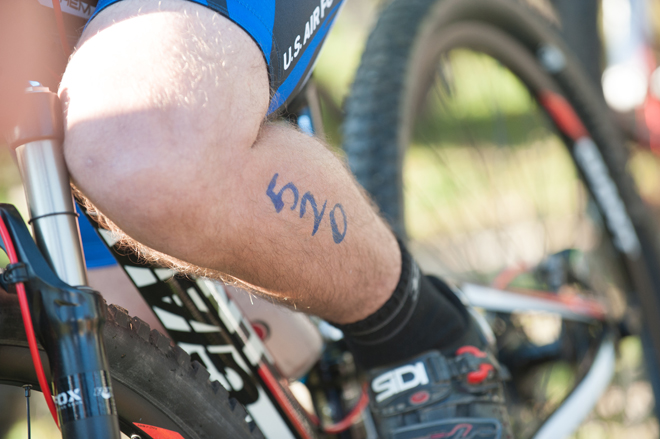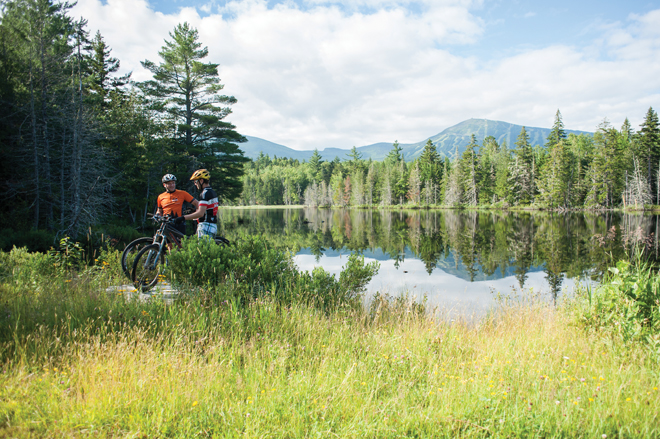Man Made
TRAVEL – December 2013
By Katy Kelleher
Photographs by C.A. Smith Photography
The Grassroots Movement to Bring Bikers to Carrabassett Valley
The smell of sweat—clean, hard-won, athletic sweat—mingles in the air with the other scents familiar to the weekend warrior: beer, mud, barbecue, and pine. The grounds at Sugarloaf are packed with people of all generations, wearing helmets and spandex, pushing bikes and wrangling kids. The sun beats down hot on my unwashed hair, and I pause to take a sip from my icy cold can. It’s race weekend at Sugarloaf, and the mountain’s summer population is out in full swing.
We’re at the finish line of the 2013 Carrabassett Backcountry Cycle Challenge, waiting for the winners to be announced. Although I am here solely as a spectator, I find myself getting a contact high from all the energy. Despite having just completed a challenging 100-kilometer course, these athletes seem to pulse with excitement, and I catch a few dancing to the reggae tunes that pump from the speakers. Competitors stop to high-five and commiserate—“I saw you beast that mudpit;” “that rocky stretch kicked my ass”—before heading off to hose down their mud-caked wheels. This is not the sleepy summer town, lying dormant and waiting for winter, that I had pictured. Instead of heading north for the powder, this crowd was drawn by rocks, roots, and dirt. They came for the trails.
Nestled within the lush and wild woods of Sugarloaf Mountain is a series of mountain biking trails that cater to all skill levels, from novice-level cruisers to professionals seeking technical rides. As the extensive system evolves, word has spread among the cycling community, making Sugarloaf the next hot spot for mountain bikers.
According to Joshua Tauses, trail manager at the Carrabassett Region chapter of the New England Mountain Bike Association (more commonly known by its acronym NEMBA), “the design is really the biggest and most important part of the trail.” A well designed trail slopes and curves; it plays with the terrain, making each rock and root count. “The building starts with surveying the property and figuring out the best places to build, staying away from low, wet areas and any undesirable features on the property,” explains Tauses as we sit side-by-side on a mossy boulder. It’s a sweltering hot day in July, the first day of the annual Carrabassett Backcountry Cycle Challenge weekend, and Tauses has taken a moment out of his busy schedule running races and organizing events to explain the nitty-gritty of trail construction, from the first survey of the property to the final run-through with a chainsaw.
“We do a lot of running back and forth along the trail line before it’s built to see if it has good ups and downs,” Tauses says between sips of his PBR. “That’s flow, they call it.”
Flow is something I hear a lot about during my weekend at Sugarloaf. Tauses is not the only one to evoke this mysterious quality, nor is he the first. When I arrive at the mountain, the first place I visit is the Outdoor Center, where I meet Bob Ash, owner of Carrabassett Valley Bike and longtime area resident. Although Tauses and Ash look little alike, they both have an easy way about them, an effortless openness that I suspect comes with living such a highly physical life. They are also both key players in the grassroots movement to bring mountain bikers to the popular skiing destination.
For the people who live here year round, the warmer months are a gift, offering reprieve from the bustle and business of winter. It is also a perfect time to retreat to the forest and enjoy the other forms of recreation offered by the imposing landscape. “I originally came here for just four months,” Ash tells me. “But I fell in love with the place, and this will be my twentieth winter here.” In his time on the mountain, Ash has seen riders and skiers come and go, but recently, he claims, there has been a rise in the popularity of mountain biking. “It’s a pendulum, it swings back and forth, and now it’s on the upswing again.”
“The Carrabassett Valley has always been recreationally oriented,” Ash says when asked why this resurgence in biking is happening here. “There’s a symbiotic relationship between the mountain and the town. There’s always the question: if the mountain wasn’t here, would the town be here?”
It’s clear to this outsider that the biking trails wouldn’t be possible without the support of the town. “The town owns this land and leases it to Sugarloaf,” explains Carrabassett Valley director of recreation Deb Bowker. “We use it for all different things, from weddings to outdoor adventure camps.” Not only is NEMBA building on town land, but thanks to Bowker (and her background in grant writing) they are also receiving funding from the town. Fit and blonde with an even tan, Bowker is an avid mountain biker herself. “A lot of us always hear people say that they want to live here year round, and why wouldn’t you?” After a minute, she adds, “I’ve got to tell you, if I could ride my bike all the time, I would.”
David Hughes, president of the Carrabassett Valley chapter of NEMBA, feels similarly about biking. Like Tauses, he is working this weekend, and when I first meet Hughes, he is standing at the finish line, waiting for the final riders to cruise in. Tall and well built, with an open, boyish face, Hughes is soft-spoken yet still commands attention. He cheers on the bikers as they emerge from the woods, wearing varying expressions of exhaustion on their faces. During the week, Hughes is a commercial real estate broker with a house in Hampden. But come Saturday, he drives to his second home in the Carrabassett Valley and spends hours riding the trails.
“You know how runners get a runner’s high?” he asks. It’s late Saturday afternoon and we’re sitting at a picnic table waiting for the awards ceremony to begin. On long rides, like the 110 kilometers course racers completed today, “you get in the zone. You get in touch with your body’s biorhythms, your breath, heart rate, and you settle into a pace that is comfortable…you can really get into your own head.” Hughes dreams of a day when they have upwards of 100 miles of trail, all built by NEMBA specifically for bikers.
“It’s a passion project,” says Hughes. “We’ve got the framework down, and now we can build like crazy. We just can’t build it fast enough.”
When asked about the 100-mile goal, Tauses is a little more cautious. “30 miles seems to be a good weekend amount of trail,” he says. “Mountain bikers are always looking for a hot new spot to ride, and our plan is to try and get into that conversation in the next couple of years. We have about five miles of brand new, purpose-built mountain biking trails for all levels of ability.” Although they have hundreds of miles of trails that one can ride, in the past few years Tauses and his crew have constructed five miles of cross-country and downhill trails made specifically for biking. Tauses goes on to explain that, in the past few decades, mountain bikers have redefined the trail building process. “It’s all about design and engineering,” he says. “There are mathematics to consider. I have a textbook that shows you all the percentages of grade, and soil types.” According to Tauses, one person, working an eight-hour day, will build just ten feet of trail. When viewed in those terms, 100 miles seems like a mighty tall order. “We’re in the beginning stages,” he admits. “It will take us a little while, but if we keep going the way we are going, in a few years we will get there.”
Despite all the painstaking calculations and slow, backbreaking labor, there is still a very raw, frantic aspect to the sport—even on Sugarloaf’s precisely planned trails. “We call it a trasher sport, because when you crash it hurts a lot,” Tauses laughs. Still, “there’s nothing better than doing what I’m doing right now. People say when you find something you love, it doesn’t feel like work.” For Tauses, perfecting the playground of his “perfect trasher sport” is not just work—it’s a lifestyle.
“I’ve been riding a bike in the woods all of my life. I fell in love with trails when I was a kid.” Now, he says, “I feel like a kid. I just go around on my bike all day.”
On Sunday morning, I wake up early to join Maine magazine photographers Chris and Cyndi Smith for a 7 a.m. ride-and-shoot mission. Although I haven’t been on a mountain bike since I was 17, I want to see the trails for myself. Perched on a borrowed bike, wearing borrowed gloves and a borrowed helmet, I push viciously down on the pedals, trying desperately to keep up with the professionals ahead of me. I approach the bike as one might approach a potentially violent animal. I’m cautious, yet ready for aggression. I push too hard and stop too short, leading to bruises and scrapes, muddy knees, and knuckles white from gripping too tight.
“You need to put your eyes where you want the wheels to go,” offers one NEMBA member who is along for the ride. I try this tactic. The change is not immediate, but as I begin to look ahead, toward the curves of the trail and the shape of the forest, I notice an improvement in my balance. A voice inside my head screams to look down, to see what exactly is happening with each root and rock, but as so often happens, that narrow viewpoint only obscures the greater picture.
A few hours later, I take part in a group ride organized by NEMBA and led by Sam Smith, a nimble, white-haired biker who has been riding here for years. We tackle a series of beginner and intermediate trails that takes us through muddy marshes, waist-high grasses, and dark coniferous forests that smell like Christmas. Our bikes bounce along trails made solely of rocks, and skid alarmingly as we speed through thick black mud. It’s exhilarating, and as I ride, the struggle to stay upright seems to fade. I find myself completely absorbed in the task at hand, challenged by the trail, but no longer afraid of it. The adrenaline rush ebbs as something else takes over, a seamless interaction between mind and body, a sweet and breathless peace. Mind, body, and bike come together to create this feeling of hard-won relief. It’s like dancing, or swimming through choppy waters.
I think it’s called “flow.”

























